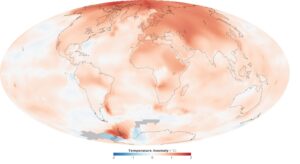In News
- A team of scientists have identified iodic acid (HIO3) which is the driver of new aerosol particle formation in the Arctic.
Arctic Amplification or Arctic Warming
- Over the past 30 years, the Arctic has warmed at roughly twice the rate as the entire globe, a phenomenon known as Arctic amplification.
- This means that global warming and climate change are impacting the Arctic more than the rest of the world.
- Global temperatures from 2000–2009 were on average about 0.6°C higher than they were from 1951–1980. The Arctic, however, was about 2°C warmer.
- Scientists first started to see evidence of changes in Arctic climate in the 1980s. Since then, the changes have become much more pronounced.

Reasons for Arctic Amplification
- Change in Albedo: It is a measure of how much light that hits a surface is reflected without being absorbed.
- Changing Ocean currents: Ocean currents normally bring in warmer water from the Pacific, and colder water exits out of the Arctic into the Atlantic. However, such currents may be changing because more melting ice is injecting the Arctic Ocean with freshwater.
- Changing Weather: Ocean currents also drive the polar jet stream, which moves hot and cold air masses around the Northern Hemisphere. This happens due to temperature differences between the Arctic and the tropics. But as the Arctic warms, the jet stream now undulates wildly north and south due to which the Arctic gets warm air.
Impact in the Arctic:
- The floating sea ice cover of the Arctic Ocean is shrinking, especially during summer.
- Snow cover over land in the Arctic has decreased, notably in spring.
- In addition, frozen ground in the Arctic, known as permafrost, is warming and in many areas thawing.
Iodic acid influences cloud formation at the North Pole
- An international team of scientists have identified iodic acid as a novel driver of new aerosol particle formation in the Arctic, which subsequently influences the formation of clouds.
- By reflecting the sun’s rays back into space or trapping heat close to the Earth’s surface like a blanket, clouds help either cool off or warm up the planet.
- Iodic acid is formed in the atmosphere from the oxidation of iodine or other molecules containing iodine.
















